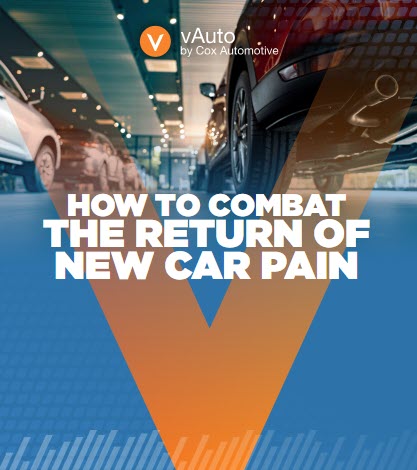Part 2: 4 Ways To Mitigate Margin Compression
If today’s used vehicle market was a house, it’d have a serious structural problem.
Let’s say the house had eight-foot ceilings 10 years ago. Today, the ceiling height is probably closer to seven feet, or even less, depending on location.
I know the shrinking ceiling analogy is slightly abstract, but it’s an apt way to describe how margin compression is changing the used vehicle business.
Consider, for example, that used vehicle prices are essentially the “ceiling” in the used vehicle market.
For a long time, dealers could effectively set the prices, or the ceiling, on a vehicle. They had great discretion and latitude.
Buyers, meanwhile, might have chipped away at the asking price, but dealers countered, and fortified their ceiling, with negotiation-savvy desk managers.
Today, things are much different. The market sets the ceiling for used vehicle pricing. And, in recent years, the rising weight of Internet-driven market efficiency and transparency put more pressure on the ceiling. As the load grows, the ceiling sags–narrowing the gross profit margin between a dealer’s cost to own a vehicle and its eventual selling price.
One might ask: “Dale, the average used vehicle transaction prices are higher, so how can the ceiling be closing in?”
It’s a valid question, but it overlooks the fact that many dealers are retailing more expensive vehicles and the margin between their cost and selling prices has been shrinking. The latest stats from NADA show that retail gross profits as a percentage of used vehicle sales prices dropped another 3 percent between 2016 and 2017—part of a downward trend that’s been occurring for several years.
In my last post, I tried to underscore why the dynamics of margin compression and market conditions make it difficult, if not impossible, for dealers to take the traditional tack of raising used vehicle prices to offset gross profit declines.
The post wasn’t intended to suggest that dealers can never raise used vehicle prices. There are instances when a vehicle’s Market Days Supply, and your retail objectives, warrant a price increase. This scenario, however, is a more calculated and market-justified move than simply increasing prices to gain more gross.
My previous post also promised four ways dealers can combat margin compression that go beyond rational, market-based pricing. Here they are:
1. Reduce inventory age. In today’s margin-compressed market, retail speed is the only way to take advantage of the age-old truth that fresh cars deliver the best gross. Dealers who sell a larger share of fresh vehicles would maximize each unit’s gross profit potential.
This is why more dealers are aiming to maintain—and retail—a larger share of their inventories under 30 days of age. I encourage dealers to maintain a minimum of 55 percent of their inventory under this threshold. I know of several dealers who actually go further, and retail 60 percent or more of their vehicles in less than 30 days.
Of course, your used vehicle pricing strategy needs to go hand in hand with your efforts to reduce inventory age and retail more vehicles while they are fresh. I encourage dealers to examine when their retail sales occur, and assess how well their age-related Price to Market adjustments and targets help them achieve a faster pace of sales.
2. Address your acquisition efficiency. At many dealerships, there are at least a handful of individuals, if not more, who have the authority to appraise vehicles. From my observations, there’s a fairly wide degree of variance among the appraisers, when you judge their decisions based on their Cost to Market ratios.
Cost to Market measures your cost to acquire the vehicle against the prevailing retail asking prices for the unit, a calculation that yields your potential profit margin spread. If you acquire a vehicle for $8,500, and the retail asking price is $10,000, the Cost to Market is 85 percent.
There’s margin to be gained by managing and measuring the consistency of your appraisals, as weighed against your Cost to Market targets. I recognize there are real-life pressures to allow a little more for trade-ins. But I would submit those pressures will fade as the current market guides the way you establish the fair value of your acquisitions.
3. Trim reconditioning time and costs. It’s not uncommon for dealers to lose several days of prime retailing time as a fresh used vehicle investment awaits reconditioning. Top-performing dealers get vehicles out of the shop in 24 hours or less, and some even market them online before the recon work, detailing and full set of photos/videos are complete. Industry studies suggest it takes an average of seven to 10 days for vehicles to be retail-ready—a timeframe that saps your margin potential.
Dealers also have an opportunity to increase their front-end gross margins by more proactively controlling their outsourced reconditioning costs. In many dealerships, used vehicle departments pay third-party vendors for upholstery, windows and other repairs without paying much attention to the invoices. That was certainly the case when I was a dealer. Given today’s margin-compressed environment, it seems reasonable to ask these partners to find ways to reduce their costs by 5 percent to 10 percent to help you preserve your profitability.
4. Manage discounting. Just as some appraisers seem to acquire cars for the right money while others don’t, some sales associates are better at avoiding discounts than their peers. When you price your used vehicles to the market, there’s simply less room for negotiation, and your average showroom/other discounts should reflect this reality.
The key, of course, is to manage and measure your discounts. Everyone who puts their initials on a deal should be held accountable for the discounts they approve—and properly trained to know how to maintain your margin in today’s more transparent market.
Dealers who adopt these recommendations, and make them operational priorities, see front-end gross profit improvement fairly quickly. As you might expect, the degree of improvement correlates directly to the level of commitment and discipline dealers put to the task.
These dealers also gain a longer-term advantage. They’ve braced and bracketed their operations to keep margin compression from doing unnecessary damage.
By contrast, their competitors are complaining that used vehicle gross profits aren’t what they used to be, while letting the ceiling shrink even more.
The post Part 2: 4 Ways To Mitigate Margin Compression appeared first on Dale Pollak.








